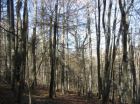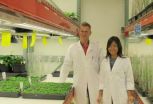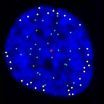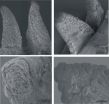(Press-News.org) The Seventies: Smog alert in the Ruhr area, acid rain, dying spruce trees in the Bavarian Forest. In those days, the solution was filter systems for the smokestacks in the Ruhr area. Today, people in the urban areas are suffering from high levels of pollution that is being caused by, among other things, automotive traffic. Particularly undesired: the nitrogen oxides (NOX). In the meantime, the European Union tightened the limit values even further; in many communities they are being exceeded. Michael Hüben of the Fraunhofer Institute for Molecular Biology and Applied Ecology IME in Schmallenberg, Germany, knows that "on stretches with heavy traffic there is a particular need for action." During the next two years, the Fraunhofer researchers want to examine in the project "Effectiveness of photo-catalytic removal of nitrogen oxide on coated building test panels" how photo-catalytic surfaces contribute to the removal of NOx and how the coatings prove themselves during long-term operation. On behalf of the German Federal Ministry of Transport, the German Federal Highway Research Institute is sponsoring and supporting the project. The process will be introduced at the 2013 BAU trade fair at the joint booth of the Fraunhofer Building Innovation Alliance.
"Coatings that are photo-catalytically active can help to reduce nitrogen oxides," explains Dr. Michael Hüben, "There are already a number of products available for the photo-catalytic coating of surfaces, but the measurement method standardized according to ISO 22197-1 cannot be applied to all problems. At the IME, we have now developed a special measurement cell which we are using in our project." At the A 4 interstate at Bergisch Gladbach, we will shortly be setting out weathering noise barrier samples that were coated with reactive material. Prepared test samples will be measured at predetermined intervals in the measuring cell. Hüben explains the set-up of the test: "The surface of the test sample must be photo-catalytically active, meaning it removes NOx when exposed to light." The surfaces contain titanium dioxide catalysts, a material that is affordable and available in large quantities. Then, exposed to daylight, titanium dioxide catalyzes the nitrogen oxide into nitrate. "The photo-catalytic activities of the samples are determined using a flow-through process," says the scientist. During the next two years, the experts will determine regularly how much nitrous oxide is being removed. In this manner, they will obtain a solid basis for the long term effects of the coatings. Only then will we be sure that the coatings really do help and that larger surfaces, such as entire housing tracts, can be economically furnished with coats that are photo-catalytically effective. This would make it possible to reduce the particle pollution in urban areas.
"Another area of application for the measurement process are interior rooms. Here, too, there are products commercially available that promise to improve air quality in interior rooms," explains Mr. Hüben's colleague, Frank Neumann from the Fraunhofer Institute for Surface Engineering and Thin Films IST. "Here, too, experimental measurements help us to work up standards and certifications and standardize existing test processes." At the Trade Fair BAU 2013, the researchers will present these and more photo-catalytic applications for the interior and exterior, using a stylized house in the booth of the Fraunhofer Building Innovation Alliance. The motto is: CITY OF TOMORROW - Intelligent Building for the City of the Future.
INFORMATION:
Clean air: New paints break down nitrogen oxides
2012-12-20
ELSE PRESS RELEASES FROM THIS DATE:
Aldrich Materials Science discovers liquid-free preparation of metal organic frameworks
2012-12-20
St. Louis, MO – December 18, 2012 – Researchers at Aldrich Materials Science, a strategic technology initiative of Sigma-Aldrich Corporation (NASDAQ:SIAL) have discovered an innovative way to design an important class of three-dimensional (3D) hybrid structures, Metal Organic Frameworks (MOFs), under completely liquid-free conditions. High purity MOF products prepared by the liquid-free process may be ideally suited as rare earth containing materials for sensors and detectors, electronic or magnetic materials. The discovery also extends liquid-free preparation techniques ...
Pair of proteins gets brain cells into shape
2012-12-20
This press release is available in German.
The study conducted by Prof. Frank Bradke's team provides indications on brain development and about the causes of diseases of the nervous system. The results have now been published in "Neuron".
Under the microscope, the brain appears as a network of intricate beauty comprising billions of nerve cells (the so-called "neurons") linked together. This network is engaged in a constant process of sharing information. The signals are transmitted from neuron to neuron through fine ramifications of the cell body. However, to acquire ...
University of Alberta research working towards treatment for aortic aneurysms in the abdomen
2012-12-20
A researcher with the Faculty of Medicine & Dentistry and the Mazankowski Alberta Heart Institute is looking closely at a molecule linked to aortic aneurysms in the abdomen, and her findings could lead to a treatment to reduce swelling of the aortic artery, which would be a life-saving treatment.
Zamaneh Kassiri, a professor in the Department of Physiology, and Ratnadeep Basu, a PhD trainee in Kassiri's lab, have been looking at the role of a protein called TIMP3 in the vessels. Their most recent findings, published in The Journal of Biological Chemistry, shows that animal ...
Death of hemlock trees yields new life for hardwood trees, but at what cost to the ecosystem?
2012-12-20
URBANA – Due to the introduction of exotic pests and pathogens, tree species are being eliminated one by one from forest ecosystems. In some cases, scientists can observe immediately how their loss affects the environment, whereas in other cases, creative puzzle solving and analysis reveal unexpected repercussions. In the case of the loss of the hemlock tree, University of Illinois landscape and ecosystem ecologist Jennifer Fraterrigo uncovered a surprising benefit to hardwood species.
Throughout much of the eastern United States, a pest called the hemlock woolly adelgid ...
Discovery may pave way to genetically enhanced biofuel crops
2012-12-20
Best known for its ability to transform simmering pots of sugared fruit into marmalades and jams, pectin is a major constituent of plant cell walls and the middle lamella, the sticky layer that glues neighboring plant cells together. Pectin imparts strength and elasticity to the plant and forms a protective barrier against the environment. Several different kinds of pectic compounds combine to form pectin. The relative proportion of each of these depends on the plant species, location within the plant, and environment. Pectic compounds decorated with β-1,4-galactan ...
Chromosome 'anchors' organize DNA during cell division
2012-12-20
LA JOLLA, CA----For humans to grow and to replace and heal damaged tissues, the body's cells must continually reproduce, a process known as "cell division," by which one cell becomes two, two become four, and so on. A key question of biomedical research is how chromosomes, which are duplicated during cell division so that each daughter cell receives an exact copy of a person's genome, are arranged during this process.
Now, scientists at the Salk Institute have discovered a new characteristic of human cell division that may help explain how our DNA is organized in the ...
From farm to table, mealworms may be the next best food
2012-12-20
Food enthusiasts interested in sustainable farm practices may soon have a new meat alternative: insects. Beetle larvae (called mealworms) farms produce more edible protein than traditional farms for chicken, pork, beef or milk, for the same amount of land used, according to research published December 19 in the open-access journal PLOS ONE by Dennis Oonincx and colleagues from the University of Wageningen, Netherlands.
The researchers compared the environmental impact of meat production on a mealworm farm to traditional animal farms using three parameters: Land usage, ...
Human history preserved in tree rings of prehistoric wooden wells
2012-12-20
Prehistoric farming communities in Europe constructed water wells out of oak timbers, revealing that these first farmers were skilled carpenters long before metal was discovered or used for tools. The research published December 19 in the open access journal PLOS ONE by Willy Tegel and colleagues from the University of Freiburg, Germany, contradicts the common belief that metal tools were required to make complex wooden structures.
The wooden water wells discovered in eastern Germany are over 7000 years old, and suggest that these early farmers had unexpectedly refined ...
Lizard tails detach at a biological 'dotted line'
2012-12-20
Like sheets of paper marked with perforated lines, gecko tails have unique structural marks that help them sever their tails to make a quick getaway. Though voluntarily shedding a body part in this manner is a well-known phenomenon, research published December 19 in the open access journal PLOS ONE reveals aspects of the process that may have applications for structural engineers making similar, quickly detachable structures.
VIDEO:
Bridging structures are not present between ...
Music with dinner: Whales sing during foraging season, not just while breeding
2012-12-20
Humpback whales might be expected to take their food seriously given their enormous size, but a new study shows that they may multi-task as they eat, singing mating or breeding songs as they forage in their Antarctic feeding grounds. The research, published December 19 in the open-access journal PLOS ONE by Alison Stimpert from the Naval Postgraduate School and colleagues, sheds new light on the whales' singing habits in different seasons, which are still a mystery.
Whales sing most frequently during the breeding season but are known to sing on other occasions, such as ...






